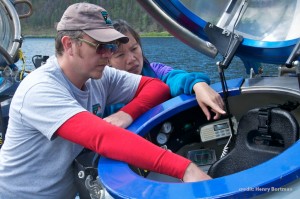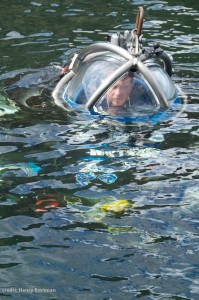By Greg Slater PhD – Researcher Organic and Isotope Geochemistry at McMaster University. I was very excited to have a chance to do both today. Last season I had to miss out on the project to due to the birth of my son Joe, it has been two years since I have had the chance to be in the Deepworker, and to see the fantastic microbialites up close and personal. It was also exciting to get a chance to begin Kelly Lake explorations. The first research I did in Kelly lake was during my M.Sc. work back in 1995. Since then I have been working with the PLRP and have been diving in Kelly several times. Although we didn’t know it in 1995, the dives showed that there were HUGE microbialites in Kelly Lake as well. The chance to work on Kelly lake microbialites in more detail this season is thrilling. In particular I can’t wait to compare the microbialites here to Pavilion Lake. The visibility in Kelly lake is not as unbelievably clear as Pavilion, and the chemistry of the water is different. These differences mean we can start to look at our question of how these microbialites are forming in a new way. The differences between Kelly Lake and Pavilion will give us a new perspective and a new way to investigate microbialite formation.
I was very excited to have a chance to do both today. Last season I had to miss out on the project to due to the birth of my son Joe, it has been two years since I have had the chance to be in the Deepworker, and to see the fantastic microbialites up close and personal. It was also exciting to get a chance to begin Kelly Lake explorations. The first research I did in Kelly lake was during my M.Sc. work back in 1995. Since then I have been working with the PLRP and have been diving in Kelly several times. Although we didn’t know it in 1995, the dives showed that there were HUGE microbialites in Kelly Lake as well. The chance to work on Kelly lake microbialites in more detail this season is thrilling. In particular I can’t wait to compare the microbialites here to Pavilion Lake. The visibility in Kelly lake is not as unbelievably clear as Pavilion, and the chemistry of the water is different. These differences mean we can start to look at our question of how these microbialites are forming in a new way. The differences between Kelly Lake and Pavilion will give us a new perspective and a new way to investigate microbialite formation.
With all this exciting potential, it was great to get the dive started. It was a little disappointing at first with the visibility being less than expected. But once I got to the slope and the target depth for the contour the visibility improved and got better – I started to see microbialites! At first they were just individual ones, about the size of softballs, sitting on the sediments. From there, the microbialites got bigger and more frequent. There were new transitions between microbialite morphologies, new variations in patterns, and also lots of similarities to Pavilion Lake. This first look at Kelly Lake was as amazing as we had hoped, and I am looking forward as we keep exploring to seeing what new things we find and what new insights we can find to understand the formation of these incredibly interesting unique microbialites.

